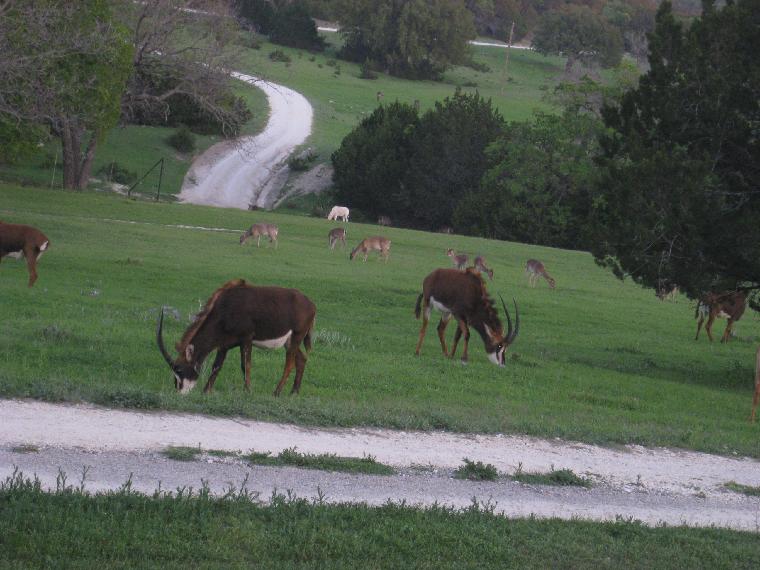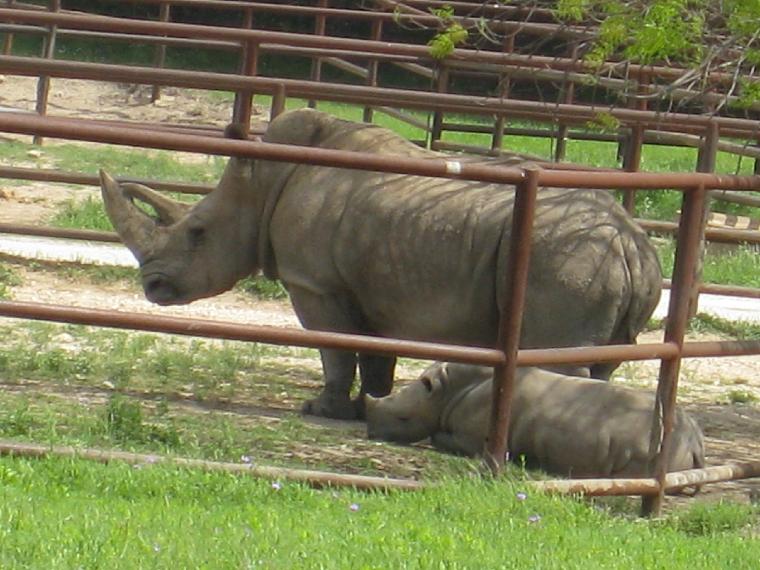An American Wildlife Preserve
The first week in April, we took our grandchildren on a trip through the American Southwest. We flew from Indianapolis to Dallas-Fort Worth, then drove a rental car to about 60 miles southwest of Fort Worth. There we stayed in the Lodge at the Fossil Rim Wildlife Center.

Mixed Herd of Antelope and Deer
Photo by Brian Strother
This resembles an African wildlife preserve; and the Lodge, a camp in such a preserve. The Lodge is enclosed in a fence, with a cattle gate at the entrance. Numerous species of antelope, mainly African, roam freely within the 1800 acre enclosure. It has the flavor of such an African camp, and we have been to several in South Africa over the years. A visit to Texas would certainly cost much less than a trip to Africa! As in an African lodge, the air conditioning was marginal, so I would recommend visiting at some time of year other than summer.

Giraffe Relaxing, an unusual sight.
Photo by Brian Strother
The breakfast is served about a mile from the lodge, in a pavilion on a hilltop. There is a large waterhole about a 100 yards from the pavilion, and there are usually a few antelope grazing in the area. At sundown, the guest can again drive up from the lodge to watch the animals come to the waterhole. The atmosphere is remarkable. My family and I recommend this as a worthwhile experience if you can't fly off to Africa this year or next. (See my South African Blog for comparisons.)

White Rhinoceros with Calf
Photo by Brian Strother
Many of the species at Fossil Rim are rare or endangered in the wild. They have herds of dozens of species of antelope and a few of deer, which graze freely within the outer fence. The rarest species are kept in enclosures away from the general animal population, but these can be visited in a private tour (advance reservations required), particularly the black rhinoceros. While zebras and giraffes roam freely in one part of the preserve, the white rhinoceros are kept in separate enclosures, as are the cheetahs. Both these species are visible on the public drive-through tours. No lions or elephants are kept at Fossil Rim.
I didn't see many flowers in Texas, but the lupines were in bloom; and where they massed, the effect was striking. These are the State Flower of Texas, the famed Texas bluebonnets. And of course, we saw people photographing their small children in the midst of the swaths of bluebonnets.
Grand Canyon and Oak Creek Canyon
From Fossil Rim, we spent two full days driving across Texas, New Mexico, and Arizona to get to Sedona. We stayed in Sedona rather than Flagstaff or Grand Canyon Village as a matter of personal taste (Sedona has an excellent selection of restauants!) We stayed at a small out-of-the-way bed & breakfast, the Sedona Bear Lodge in West Sedona. The new owners specialize in gourmet breakfasts, and are eager to make your visit comfortable and pleasant. We enjoyed our three nights (and breakfasts) there.
One day we drove to the Grand Canyon, a trip of about 2 to 2½ hours, including the scenic drive through Oak Creek Canyon. Sedona is located at the mouth of Oak Creek Canyon, and my father was enamored of the small jewel almost in the shadow of the Grand Canyon. When I was just a kid, our family would drive through Oak Creek Canyon on every vacation trip from Indiana to the Southwest.
I have to say that I have never been down into the Grand Canyon. Just standing on the South Rim and looking down into the Canyon is all I am game for. It is still stupendous and overwhelming, just standing on the Rim. I think they still must give mule rides down into the Canyon, since there is still a mule barn and paddock with mules in Grand Canyon Village. Sixty years ago, my mother took one look at the mules and another look over the rim, and refused to get anywhere near a mule. You could walk the trails down into the Canyon then and you can still do that, but be aware that the climb back up out of the Canyon is very hard (the Rim is at about 7000 ft. elevation), it can be very hot down in the Canyon, and the rangers won't be happy if they have to drag your exhausted carcass up out of there because you underestimated the difficulties.
Flowers Back Home
The dogwoods are in full bloom, but the redbuds have gone over. The Narcissus are almost all gone now. Arisaema ringens and Arisaema sazensoo were starting to bloom when we left for the Southwest and were in full bloom when we returned home. Claytonia virginica was in bloom before we left; a few of the Trillium are in bloom now. The weather seems to have been dry for the last two weeks, with rain promised for this weekend.
I noticed that I have quite a few volunteer seedlings of Fritillaria acmopetala in one bed. Only one other frit has volunteered for me, F. crassifolia kurdica. A few others are somewhat hardy here, including F. pallidiflora and F. thunbergii, but they either don't set seed or at least don't seed around. A few patches of Ipheion uniflorum are in bloom, one probably 'Wisley Blue' and the other paler, nearer white in color, with no cultivar name.
In the greenhouse, Hippeastrum glaucescens seems to have set seeds, so is probably the true species rather than some random garden hybrid. This species is diploid, and if crossed with a tetraploid should be a completely sterile triploid. In a few years, maybe we will see what the offspring look like. Note that some Hippeastrum hybrids are fertile, e.g. [papilio x mandonii] is quite fertile, and I have a pot of F2 seedlings growing on. My Hippeastrum evansiae are in bounteous bloom just now; they are usually much less generous with their flowers. They all seem to be from a single clone, as no pure evansiae seeds have ever been formed.
You have to be a "Friend" to see my stuff in Facebook (http://www.facebook.com/ShieldsGardens). If you try to "Friend" me, be sure to drop me a note explaining who you are! If I don't recognize your name, I'll ignore the request. Don't count on my memory, because it does not work all that reliably anymore.
Good gardening, from here in central Indiana
Jim
<shieldsgardens@gmail.com>
Look up technical terms in the Glossary of Plant Biology